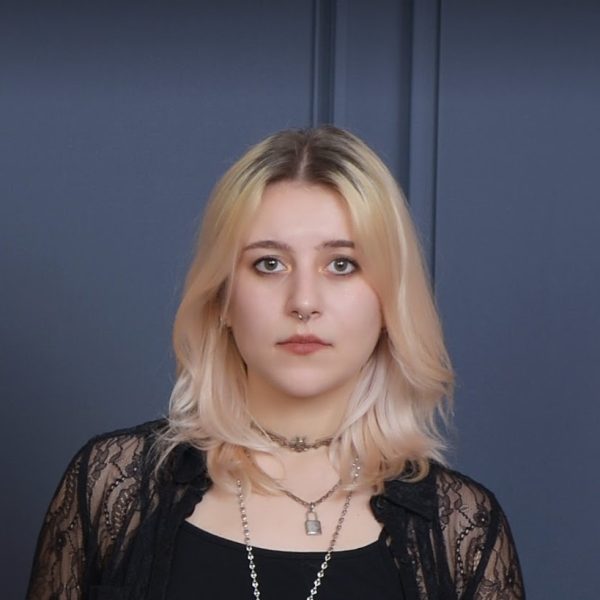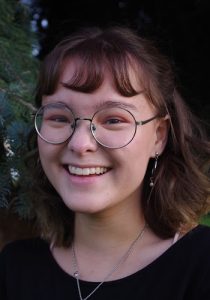Arts x Opinion: The Entanglement of Marginalized Identities and Horror
(Graphic by Brenda Payan Medina | The Daily Utah Chronicle)
December 30, 2022
The horror genre carries a complicated history and certain magnetism for marginalized identities. Horror frightens audiences by showing them the unacceptable and undesirable — things that go against the grain of the world and challenge our society’s setup. For people of marginalized identities, the genre preys upon us, uses our identities as a shock factor and even contributes to our antagonization. At the same time, we historically find ourselves within horror stories, regardless of whether this representation was intentional.
Because horror hasn’t been kind to many identities, it rests on a controversial foundation. And while it has grown over time, particularly into the mainstream, horror’s controversy remains.
Angela
Horror has generally treated women and queer people cruelly. Whether that means excessively gruesome on-screen portrayals of sexual assault and murder, or abuse of the actors themselves, horror has traumatized us in many ways. Some horror films uphold our society’s standards and practices: the final girl trope, for example, has historically pushed the narrative that the “good” girl gets to survive. This good girl, of course, is a virginal character that doesn’t stray from the moral path or traditional values — though what it means to be the final girl is changing.
With that said, horror still treats us better than the rest of the film industry a lot of the time. So much of the horror genre has been something of a haven because of the questions and challenges it poses to society. As outcasts, we feel validated and understood. The causes of our repression and isolation come to light, and we revel in the bittersweetness of it.
As a queer woman, watching horror can feel like holding a mirror up to myself. I spent a lot of my life avoiding feelings that scared me, deluding myself into a false sense of security. However, as horror movies show us, you can’t run or hide forever. Things catch up with you in one way or another.
Like Lily from “Black Swan,” I’ve lost a good portion of my life to chasing approval and success. Oftentimes, I feel like I don’t know myself anymore and get scared trying to figure it out like Justine, the cannibal from “Raw.” And as I come into myself, I feel more and more driven to conflict and rage like Needy from “Jennifer’s Body.” I see myself in the queer-coded lost girls and monstresses running from the shadows that are beginning to catch up to them.
And while I relate to the terrifying thrill of that chase, I also find the endings cathartic. Eventually, the heroine (or antagonist, depending on how you see it) either succumbs to the shadows or stands her ground and comes out of the situation on her own terms. Either way, she doesn’t have to run anymore.
Kayla
I find myself drawn to particular women in horror: the villains, the monsters, the ones we love to condemn as evil. Something about them fascinates me. Women like Jennifer from “Jennifer’s Body” captivate me. They subvert societal norms and take on roles that are rebellious, so unlike traditionally feminine character types.
Working in a haunted house opened my eyes to the ways that gender plays a part in horror. Because of both my gender and stature, being that I am under 5 feet tall, I have an assured in for playing the female-fronted roles. I, as a short woman, scare men far more often than I scare other women. Because these characters do not pander to what society expects of them and don’t need (and often despise) male validation, they are seen as wild cards.
While I love scaring people, it’s also important to take a step back and recognize the harm that horror has done.
In Stephen King’s “It” and “It: Chapter Two,” there are numerous examples of blatant racism and homophobia. While some of it makes sense in context of the book, I bear a special hatred for the start of the sequel. Almost immediately, a gay couple is violently hate-crimed, when it was frankly unnecessary for the plot. There were so many other ways to show that Pennywise was back after nearly three decades, and that thematic choice to keep it in the film was cruel to queer viewers. I enjoyed these movies, but I couldn’t keep these scenes out of my head. Why is this one of the primary roles that queer people are allowed to inhabit? Why are we so often the victims, the throwaway characters that get killed off and forgotten?
I love horror, but I’m also a queer woman of color, and the genre doesn’t want to make a space for me. Regardless, as marginalized groups have done time and time again, I’ll make my own seat at the table.
Whit
As a teen, I never connected to horror. It felt gross, terrifying and out of touch with what I knew to be my lived experiences. Today, I love settling in for late-night marathons of horror flicks — particularly those with queer, trans, disabled and otherwise diverse characters.
Some of the most exciting horror to me starts with the stories I see myself in. “They/Them” is one of few horror films to center queer antagonists and protagonists alike against a backdrop of a conversion camp where homophobia and bigotry are the true horrors. The “Fear Street” films were great for representation of queer histories and for detailing homophobia’s prevalence historically, connecting back to queer resilience in the present. Many films fail to do the same.
Most of Mike Flanagan’s works — namely “Midnight Mass” and “The Midnight Club” — have been vocal about queer characters and often silhouette them against his characteristically long-running monologues. But simply seeing queer characters on the screen is not enough, nor is adding them for the sake of representation. Even with layers of character development, the casting of queer actors in queer roles and as protagonists in film and television lead to the use of homophobia and bigotry as devices to advance the plot.
Things are looking up with media like “Fear Street” and “The Midnight Club” providing queer community among older queer characters and queer youth. But queerness in film and television still has advancements to make: queer perspectives have been long underrepresented in horror — an issue that today’s movies and television still struggle with.
The few examples of queer characters in horror tend to fall prey to the issue of relying on trauma and the real homophobia faced by people with queer identities. The trend of using representation as a justification for traumatic experiences and regurgitations has never been a valid one. This pattern is visible in “It: Chapter Two,” in the aforementioned scene.
While the film takes place in a time when crimes of this nature are prevalent, the scene is a violent re-traumatization of assault and bigotry directed at displays of queer affection inspired by true events.
“They/Them” centers queer characters and gives them the narrative power to overcome bigoted counselors and the tense environment of a conversion camp, but it uses graphic depictions of queer conversion, torture, transphobia and misgendering to prove an often too-on-the-nose point about how sinister these actions make the film’s villains. It sheds light on traumatic experiences — but does so to a degree that queer viewers who struggle with similar experiences stand to lose more than they gain by watching the film.
Instead of victimizing queerness, I’d rather we villainize queer characters as holders of power in the genre and do more to remember that queer histories are as important as the queer present.
Representation Moving Forward
Representation isn’t free of flaws. Clearly, all representation doesn’t equal good representation, and we certainly shouldn’t use it for trauma or plot devices. That leaves the future of representation: where will queerness, people of color, people with disabilities and other marginalized identities in horror go?
We’re excited for more diverse queer and trans protagonists and antagonists – characters with power and agency to face monsters and dilemmas. We look forward to seeing queer disabled characters who aren’t killed off to garner pity from the audience, but who are centric to the narrative. We want to see films connecting between past and present queer experiences and ways of being, allowing for the humanization of queerness.
We’re also excited to see how movies will navigate the shift of marginalized identities, especially queerness, from subtext to explicit messaging. Instead of the homophobia and shallow characters we currently see, we’re hoping for more fresh perspectives from people who haven’t been given the same platforms to speak.
With a genre so powerful, everyone deserves to be in control of their own narrative.











